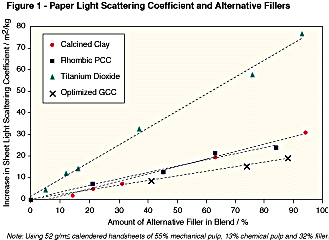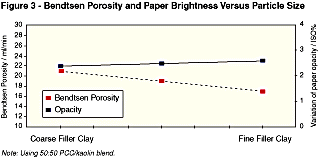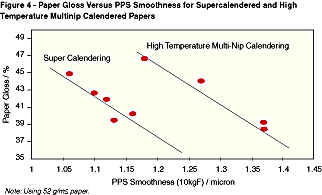|
Following on from our look at the SC market set-up, we investigate some of the alternatives materials available and some of the pitfalls
by Marielle Lorusso and Jonathan Phipps
Taking your fill of uncoated groundwoods
For the majority of SC papers applications in Europe, the publisher may choose to use the uncoated grade rather than a coated groundwood primarily for reasons of price. SC and LWC grades frequently compete for the same customers and because LWC is able to outperform SC in most measures of quality, the cost advantage that the SC producer has is vitally important.
Nevertheless, for the customer to be able to take advantage of the savings from SC, the grade needs to fulfil some minimum quality standards. One factor is opacity. Indeed, this is one of the few properties in which SC paper can outperform LWC. In contrast, coated papers invariably have an advantage in brightness and print quality, but if the SC manufacturer can gain improvements to these properties without losing cost advantage or press room efficiency, then the producer can gain access to a broader range of customers.
The role of filler is crucial in determining the SCA paper properties and it has a major influence on production cost through runnability issues. Most European SC papers are still produced under acid conditions using predominantly kaolin fillers. The characteristics of these fillers have been developed to offer optimized all-round performance. Typical kaolin fillers for SC have relatively coarse, platey particles, which give the paper excellent strength properties and allow high loading levels to be achieved. They also offer good first pass retention, low porosity and high gloss and smoothness levels.
Before considering the effects of different filler types on SC sheet properties, we look first at the effects of loading for a conventional kaolin filler. For a given sheet weight, increasing the filler loading will always be desirable as it will reduce overall raw material costs. But for SC papers it is also beneficial to many sheet properties. In particular, it helps boost the properties that affect printability such as gloss, smoothness and porosity. This occurs because the filler particles are much finer than the fibers and can fill up the voids. In the case of platey kaolins, there may also be a contribution to gloss from alignment of the particles.
Although fillers generally scatter light more strongly than fibers, the densification of SC papers on the calender is such that the scattering power of fillers is significantly reduced. As a result, the opacity of SC papers may sometimes even decrease slightly with filler loading, because the effects of a small increase in light scattering are more than offset by the reduction in light absorption as the fibers are progressively replaced. This is due to the fact that the fibers are the major contributor to light absorption in groundwood papers.
Sheet strength is also reduced by fiber replacement. Not only are there fewer fibers available for bonding, but the presence of the filler reduces the area of contact. Sheet strength is normally the most important factor limiting the maximum loading that can be achieved, although reduced bulk, filler retention and sheet dewatering may also be a consideration.
There are basically two ways to modify kaolin fillers - the filler can be bleached or its particle size distribution can be changed. Bleaching a filler will improve its powder brightness by reducing its absorption. This also produces a corresponding improvement in sheet brightness. However, as sheet light absorption is normally dominated by the fibers used in SC papers, only modest improvements in sheet brightness can be obtained by this strategy.
A reduction in absorption will also be detrimental to sheet opacity. If an increase in just brightness is required and a loss of opacity can be tolerated, the most cost-effective solution is likely to be to increase the proportion of bleached fiber used, rather than changing the filler.
Simultaneous improvements in both brightness and opacity can only be achieved by an increase in light scattering. The coarse particle size distributions used in kaolin SC fillers offer high levels of first pass retention and paper strength, but do not represent the optimum for light scattering. As a result, there is scope to improve both brightness and opacity by using a finer kaolin filler.
Changing the mean filler particle size affects sheet brightness and opacity. An improvement of two units of sheet brightness and one and a half units of opacity can be obtained by switching from a coarse kaolin to a fine one. In contrast, by bleaching the coarse kaolin to the same pigment brightness as the fine one, only one unit of sheet brightness is obtained, and half of one unit of opacity is lost.
At the same time, the particle size distribution will have a significant effect on other properties, as well as sheet light scattering. A reduction in mean particle size will increase gloss and smoothness, while decreasing porosity. Print gloss and linting propensity will also improve. For rotogravure papers the percentage of missing dots will tend to be reduced by an increase in smoothness, but conversely it will increase if this is accompanied by a reduction in the compressibility of the paper. Paper strength and bulk decrease with finer particle size. Finally, reducing the mean particle size of the filler will often have an adverse effect on runnability through reduced retention.
In short, improvements in brightness, opacity, smoothness, gloss, print gloss and porosity can be obtained by switching from a coarse kaolin filler to a fine one, but the change could impair runnability.
The addition of alternative fillers can enhance paper brightness. Compared with kaolins, most of the alternative fillers that could be used in SC papers will have a lower particle aspect ratio (ie they will be less platey), which will lead to looser particle packing in the sheet and increased void volume. Introducing more void volume into the sheet will increase sheet light scattering by creating a greater fiber/air and filler/air interfacial area.
Alternatively, light scattering may be improved by using a filler with a higher refractive index. Fillers such as PCC (precipitated calcium carbonate) and calcined clay can be used to increase void volume, whereas the only filler with a significantly higher refractive index than kaolin is titanium dioxide (Figure 1). Titanium dioxide is by far the most efficient here, but price means that it is not necessarily the most cost-effective. Although calcined clay and PCC showed very similar increases in light scattering, the clay gives better sheet brightness and the PCC gives better opacity. This is due to the effects of the PCC on the pH at which the sheet was formed - the higher pH induced by the PCC has caused some alkali darkening of the fibers. This effect can occur on a paper machine, but careful attention to wet end chemistry and, if necessary, the use of a neutrally buffered PCC will prevent these problems.

Although all of the alternative fillers increase light scattering substantially, their effects on other paper properties may vary considerably. For PCC or calcined clay, a substantial loss of paper strength would be expected as they will cause more severe fiber debonding than the conventional fillers. Titanium dioxide fillers do not increase pore volume, but will reduce the sheet strength somewhat as a result of their fine particle size. There is always a compromise to be made between light scattering and sheet strength.
As a function of light scattering, alternative fillers will often give a reduction in gloss as they increasingly replace the kaolin. The platey kaolin filler generates high glossing potential, which is lost as it is progressively substituted. However, high gloss and light scattering can be achieved with alternative fillers if the calendering conditions are designed carefully.
The other major changes induced by the alternative fillers (with the exception of titanium dioxide) are increased porosity and bulk. Although an increase in bulk can be considered beneficial, an increase in porosity is usually associated with lower print density and print gloss (Figure 2).


It is clear that alternative fillers can lead to substantial improvements in brightness and opacity, but these come at a significant cost in paper strength and printability. As a result, suppliers such as ECC have been investigating ways to offset the adverse effects of these fillers by changing the nature of the kaolin used in the mix. Substituting a coarse kaolin with a finer one will lead to simultaneous improvements in gloss, porosity and ink hold-out, while retaining the required higher levels of brightness and opacity associated with the alternative filler. For example, Figure 3 shows the effect of reducing the particle size of the kaolin on porosity for a blend of 50:50 clay/PCC.
The use of a finer kaolin will offset some of the loss in gloss and printability in papers containing specialty fillers, but it will tend to compound the loss in paper strength. It may be possible to offset this effect with changes in fiber quality, or with increased use of strength aids. With the increasing use of gap formers to produce these grades of paper, higher levels of retention and drainage aid use may also be possible, while still maintaining good sheet formation.
As an alternative to the use of finer kaolin, the introduction of high temperature multinip calendering technology has allowed high gloss levels to be obtained while maintaining sheet bulk and compressibility. Figure 4 shows the difference in gloss/smoothness ratios that can be achieved, compared with conventional supercalendering.

There is still relatively little production scale data available on the effects of this type of calendering on papers filled with high bulking fillers. But it seems likely that the low glossing potential of these papers can be at least partially offset in this way.
Bulking up
It is worthwhile noting the effects of alternative fillers on runnability and wet end chemistry. High bulking fillers are likely to increase the rate of water drainage from a forming paper web. But they will also enable the wet sheet to hold more water, so they could also increase the sheet moisture content after pressing. Depending upon the limitations of the paper machine being used, this combination of effects may lead either to an increase or decrease in productivity.
Finer fillers are generally more difficult to retain than coarse ones. But in the case of aggregated particles, the overall aggregate size may be similar to that of a coarse filler, so it may not present a problem. Titanium dioxide fillers are considerably finer than most other fillers as their high refractive index reduces the optimum size for light scattering to below 0.5 microns. Not only are these particles difficult to retain, but they can also suffer from severe loss of scattering power if they become flocculated with each other. In view of this tendency, careful wet end control is needed to maximize the performance of titanium dioxide fillers.
The use of calcium carbonate fillers prevents the papermaker from running under acid conditions, making it necessary to convert to neutral conditions. Converting is sometimes associated with a decrease in pulp brightness, usually referred to as "alkali darkening". Neutral conditions also promote pitch formation, because the fatty substances that comprise groundwood pitch are increasingly extracted as pH rises. The process can also promote biological growth, because many bacteria and fungi prefer neutral conditions and feed off the increased levels of extractives. These problems clearly have to be addressed if calcium carbonate is used and will normally lead to a slight increase in machine running costs.
There remains some flexibility in the choice of machine pH though. Even though calcium carbonate suspensions have a natural pH above 8, it is possible to obtain a steady machine pH of less than 7 using only small additions of alum or sulfuric acid. This is possible because the dissolution rate is very low at this pH, and dissolution may sometimes be prevented altogether by a build-up of dissolved carbon dioxide in the whitewater.
Many LWC machines that use calcium carbonate as part of their coating formulation (which returns to the wet end as broke) operate in this way, which is often referred to as "pseudo-neutral" running. The use of PCC may bring additional problems as a result of its tendency to produce higher pH than GCC. However, should this be a problem, then neutrally buffered PCC can be used to prevent dissolution and stabilize the pH of the system.
Balancing the mix
The coarse kaolin fillers predominantly used in SC papers today represent a sensible compromise between runnability, optical and physical paper properties. There is considerable scope though, for manipulating the key properties of SC papers by a careful choice of alternatives. With kaolin fillers, a reduction
in particle size can
offer improvements in brightness, opacity, gloss and print properties. More substantial improvements in brightness and opacity can be obtained by mixing kaolin with a different type of filler such as PCC or calcined clay. These materials will increase bulk and light scattering by introducing void volume into the paper sheet.
However, the use of such fillers will be detrimental to other paper properties such as gloss, porosity and printability. These losses in quality may be partially offset through the optimization of the remaining kaolin filler.
In all cases, the use of a different type of filler will have implications for machine runnability, both through reductions in paper strength and retention. For calcium carbonates, it will also require neutral operation.
Many of these difficulties may be overcome by improvements in machine and chemical technology, but given the importance of production costs to the SC papermaker, they may ultimately be the key factor in determining the optimum filler options for the future.
Marielle Lorusso and Jonathan Phipps work for ECC International, headquartered in St Austell, UK
|